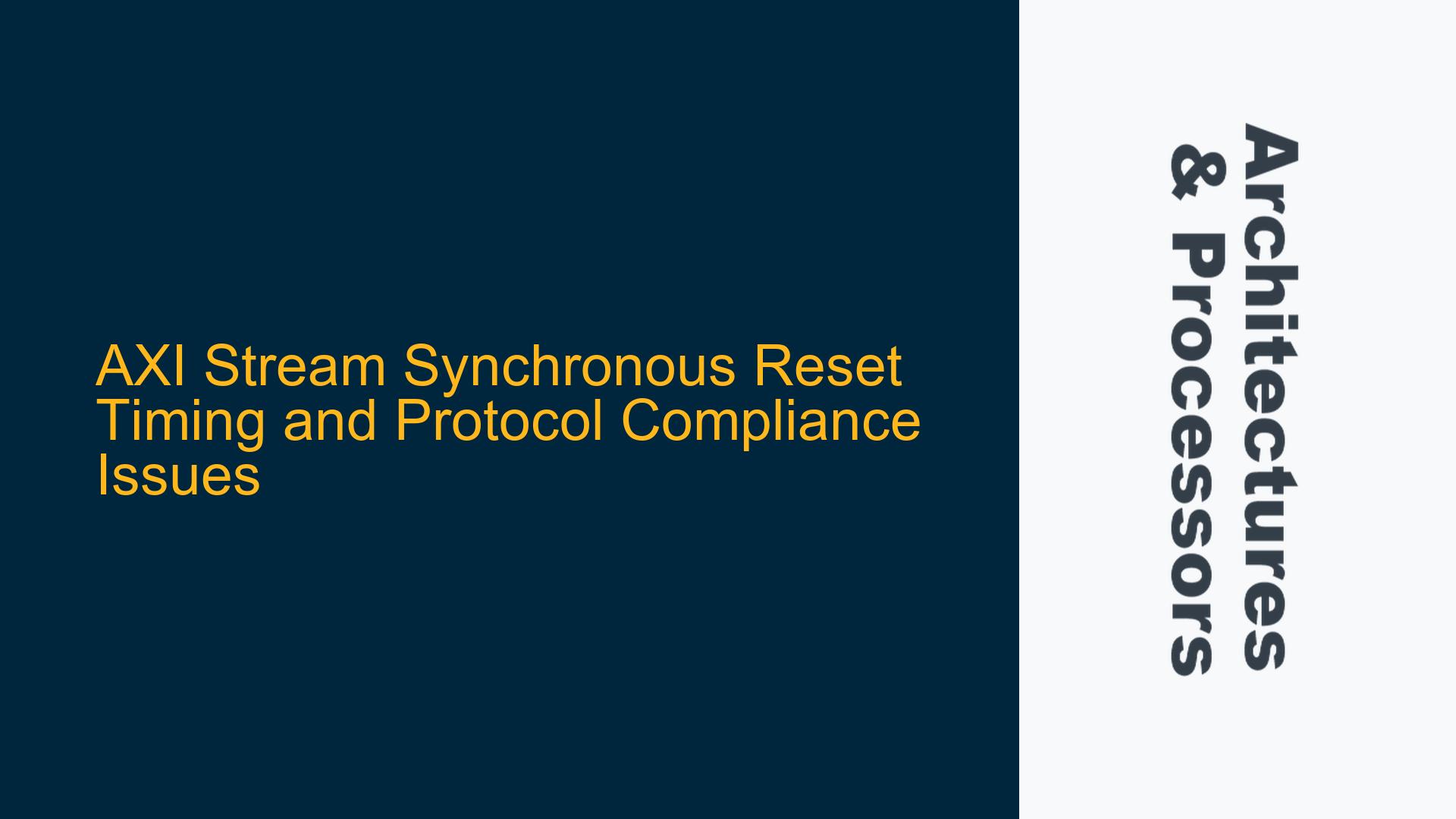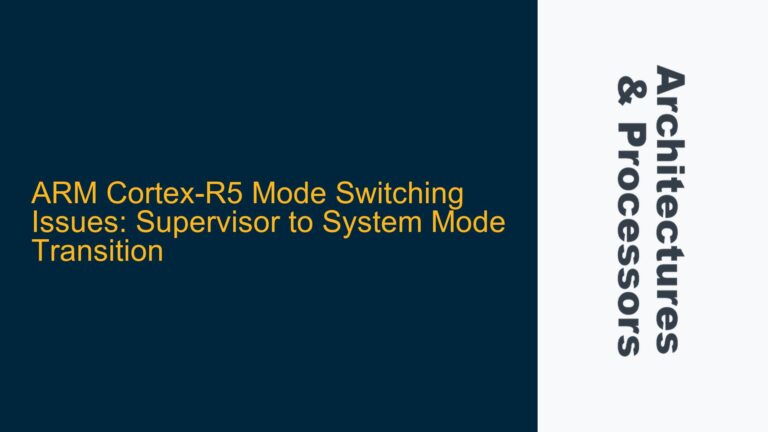AXI Stream Protocol Reset Requirements and FPGA Implementation Conflict
The AXI Stream protocol specifies that the reset signal, ARESETn, can be asserted asynchronously but must be deasserted synchronously with the rising edge of the clock signal, ACLK. This requirement is critical for ensuring predictable behavior during system initialization and recovery. However, FPGA design guidelines often recommend using synchronous resets to avoid potential metastability issues and to simplify timing analysis. This creates a conflict between the AXI Stream protocol’s reset requirements and typical FPGA design practices.
In the context of the AXI Stream protocol, the reset signal ARESETn is active-LOW, meaning that the system is in reset when ARESETn is LOW. During reset, the TVALID signal must be driven LOW, while other signals can be driven to any value. The protocol allows for asynchronous assertion of the reset signal, but the deassertion must be synchronous with the clock. This ensures that all components in the system come out of reset in a predictable manner, aligned with the clock edges.
FPGA design guidelines, on the other hand, often favor synchronous resets. Synchronous resets are easier to manage in FPGA designs because they are inherently aligned with the clock domain, reducing the risk of metastability and simplifying timing closure. However, this approach can conflict with the AXI Stream protocol’s requirement for asynchronous assertion of the reset signal. When using synchronous resets in an FPGA implementation, the reset signal is only recognized at the rising edge of the clock, which may not align with the protocol’s requirement for asynchronous assertion.
This conflict becomes particularly evident during verification, where tools like Questa QVIP assertion checkers enforce strict compliance with the AXI Stream protocol. If the RTL implementation uses synchronous reset assertion, the verification tool may flag this as an error because it does not adhere to the protocol’s requirement for asynchronous assertion. This raises the question of whether the protocol’s requirement is strictly enforced or if it allows for some flexibility in implementation.
Synchronous Reset Assertion and Verification Tool Constraints
The core issue arises from the interpretation of the AXI Stream protocol’s reset requirements and how they are implemented in RTL code. The protocol states that the reset signal "can be asserted asynchronously," which implies that asynchronous assertion is allowed but not strictly required. However, the deassertion of the reset signal must be synchronous with the clock. This distinction is crucial because it affects how the reset signal is handled in the design and how it is verified.
In the case of FPGA implementations, synchronous reset assertion is often preferred due to the reasons mentioned earlier. However, this approach can lead to conflicts with verification tools that enforce strict compliance with the protocol. The Questa QVIP assertion checker, for example, may flag synchronous reset assertion as an error because it does not adhere to the protocol’s requirement for asynchronous assertion. This creates a dilemma for designers who must balance the need for protocol compliance with the practical considerations of FPGA design.
The key question is whether the protocol’s requirement for asynchronous reset assertion is a strict rule or a guideline that allows for some flexibility. If it is a strict rule, then the RTL implementation must be modified to comply with the protocol, even if it goes against FPGA design guidelines. If it is a guideline, then the RTL implementation may be allowed to use synchronous reset assertion, provided that the deassertion is synchronous with the clock.
To resolve this issue, it is important to carefully analyze the AXI Stream protocol specification and understand the intent behind the reset requirements. The protocol’s wording suggests that asynchronous assertion is allowed but not strictly required, which implies that synchronous reset assertion may be acceptable as long as the deassertion is synchronous with the clock. However, this interpretation may not be universally accepted, and verification tools like Questa QVIP may still flag synchronous reset assertion as an error.
Resolving Synchronous Reset Timing Issues in AXI Stream Implementations
To address the conflict between the AXI Stream protocol’s reset requirements and FPGA design practices, several steps can be taken to ensure compliance while maintaining the benefits of synchronous resets. The following troubleshooting steps, solutions, and fixes can help resolve the issue:
-
Review the AXI Stream Protocol Specification: Carefully review the AXI Stream protocol specification to understand the intent behind the reset requirements. Pay particular attention to the wording of the reset signal requirements and whether asynchronous assertion is strictly required or simply allowed. This will help determine whether synchronous reset assertion is acceptable in the context of the protocol.
-
Modify the RTL Implementation: If the protocol’s requirement for asynchronous reset assertion is deemed strict, modify the RTL implementation to comply with the protocol. This may involve changing the reset logic to allow for asynchronous assertion while ensuring that the deassertion remains synchronous with the clock. This can be achieved by using a combination of asynchronous and synchronous reset logic in the design.
-
Adjust Verification Tool Settings: If the protocol’s requirement for asynchronous reset assertion is considered a guideline rather than a strict rule, adjust the settings of the verification tool to accommodate synchronous reset assertion. This may involve modifying the assertion checkers or adding exceptions to the verification process to account for the use of synchronous resets in the design.
-
Consult with the FPGA Vendor: Consult with the FPGA vendor to understand their recommendations for handling reset signals in the context of the AXI Stream protocol. The vendor may provide guidance on how to implement synchronous resets while maintaining compliance with the protocol, or they may offer tools or IP cores that simplify the process.
-
Perform Timing Analysis: Perform detailed timing analysis to ensure that the reset signal meets the timing requirements of both the AXI Stream protocol and the FPGA design. This includes analyzing the setup and hold times for the reset signal relative to the clock signal, as well as ensuring that the reset signal is stable during the deassertion process.
-
Simulate and Verify the Design: Simulate the design using the modified RTL implementation and verify that the reset signal behaves as expected. This includes checking that the reset signal is asserted and deasserted correctly, and that the system enters and exits reset in a predictable manner. Use the verification tool to confirm that the design complies with the AXI Stream protocol and that no errors are flagged.
-
Document the Design Decisions: Document the design decisions and the rationale behind the chosen reset implementation. This includes explaining why synchronous reset assertion was used, how it complies with the AXI Stream protocol, and any adjustments made to the verification process. This documentation will be valuable for future reference and for communicating the design approach to other team members or stakeholders.
By following these steps, it is possible to resolve the conflict between the AXI Stream protocol’s reset requirements and FPGA design practices, ensuring that the design is both compliant and optimized for the target hardware. The key is to carefully analyze the protocol specification, understand the intent behind the reset requirements, and make informed decisions about the RTL implementation and verification process.
In conclusion, the issue of synchronous reset timing in AXI Stream implementations is a complex one that requires careful consideration of both the protocol requirements and the practicalities of FPGA design. By taking a systematic approach to troubleshooting and resolving the issue, it is possible to achieve a design that is both compliant with the AXI Stream protocol and optimized for the target hardware. This involves reviewing the protocol specification, modifying the RTL implementation, adjusting verification tool settings, consulting with the FPGA vendor, performing timing analysis, simulating and verifying the design, and documenting the design decisions. With these steps, designers can ensure that their AXI Stream implementations are robust, reliable, and compliant with the protocol.






